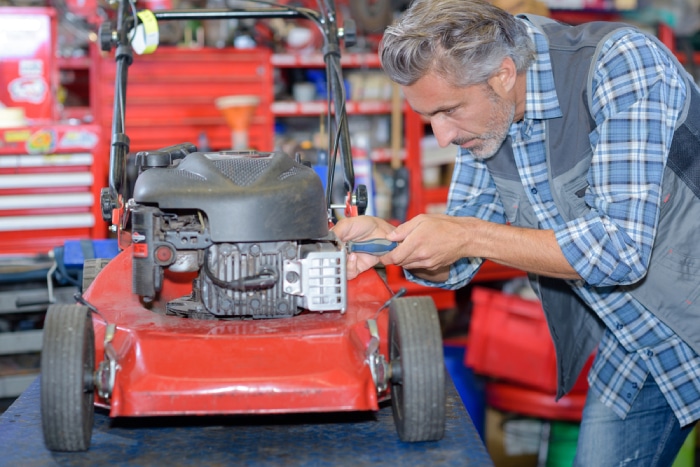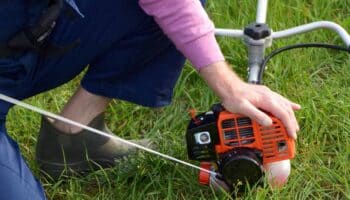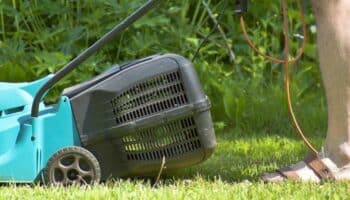Does your mower have a faulty, damaged, or even a missing primer? In this article, we’ll show you how to get your mower going without using the primer. And have you back mowing within 5 minutes.
Starting a mower without a primer is quick, easy, and doesn’t require lots of tools or complications. You can have your mower up and running in no time with this simple guide.
In order to start your mower without a primer, squirt starter fluid directly into the carburetor via the air intake. Simply remove the air filter cover, take out the air filter, and squirt starting fluid into the air intake nozzle. Quickly replace the air filter, and start your mower. It should start straight away.
I’d recommend reading this in more detail though. Ready to start a lawn mower without a primer – in under 5 minutes? Let’s get started!
What you’ll need
For this little work around you won’t need much:
- Starter fluid
- Screwdriver (If you need one to help you remove the air filter cover)
Step-by-Step Instructions
Step 1: Preparation
The first step is obviously to get your mower ready. Make sure it’s on a flat surface, so it doesn’t roll anywhere. You can chock a front wheel with a block of wood if you want to be safe. If the mower has a parking mode or brake, make sure it’s engaged.

Usually, when performing maintenance on your mower, you should remove the spark plug cable. This makes sure the blades can’t go around accidentally. But since this is about starting your mower, you can’t do that. Just make sure you keep your hands away from the blades at all times.
Step 2: A quick check
While you have your mower parked up, it’s worth giving it a quick visual check to make sure there are no other issues than the primer.
Pull the cover off the mower. Check the fuel tank and fuel line for leaks or damage. Inspect the connections around the carburetor to make sure they’re secure.
If nothing looks out of place, damaged, or leaking, then you can move on to starting the mower. Give your lawn mower’s manual a read or find it below so you’ll know what to do.
Step 3: Removing the air filter
Locate the air filter housing. It’s usually a plastic box next to the carburetor.
Remove the air filter cover. This will either be clipped on with little plastic retaining clips or screwed down. You should always try to be gentle with the air filter housing so as not to damage the air filter.
Once the cover is off, make a note of how the air filter sits in the housing (or take a quick pic with your phone). This is just to make sure you know which way around to put it back. If you put the filter in the wrong way around you can damage it, and possibly your mower, and you’ll definitely have trouble starting it.
Gently remove the air filter. Behind the filter is the air intake nozzle. This hole leads directly to the carburetor, and it’s where you’re going to spray the starter fluid.
Step 4: Starter Fluid
Starter or starting fluid is a highly flammable mixture of volatile compounds designed to help start cold or difficult-to-start engines.
Because the fluid is very volatile, it evaporates quickly. So, the trick to using it for your lawn mower is speed. Once you’ve squirted it into the carburetor, you need to get the air filter and cover back in place as quickly as you can.
A single 2-3 second squirt should be enough. Too much and you risk choking it (that’s not a major issue, you just have to wait a few minutes for the fluid to evaporate, before starting again).
Step 5: Replacing the air filter
As soon as you’ve squirted your starter fluid into the air intake, get the air filter back on. An optimal balance between care and speed. You don’t want to damage the filter and you don’t want the fluid to evaporate.
This is where taking careful note of how the filter sits before you take it off can help. With the filter back in, (the right way around) put the air filter cover back on.
Step 6: Start your mower
That’s it! Start your mower and it should fire up at once.
If your mower doesn’t start after a few pulls, try the steps again. Checking the air filter and the amount of starter fluid you use. If it still doesn’t start, the issue is probably not just your primer and you’ll need to investigate further.
Why do lawnmowers need a primer bulb?
A lawn mower has a primer bulb because the carburetor is quite small. A carburetor mixes air and gas in the right quantity before injecting it into the combustion chamber of your engine. A small reservoir of fuel collects in the carburetor bowl. The action of the engine naturally draws fuel from the fuel tank.
But when the engine hasn’t started, the only fuel in the carburetor bowl is what’s left from the previous time you used the mower. If some time has passed since the last time the mower was running, the gas in the carburetor can have evaporated. So, for the engine to start, you need to pump new gas into the carburetor from the fuel tank. And that is what you are doing when you pump the primer bulb.
Without the primer bulb, you need an alternative method to get fuel into the carburetor to start the engine.
Alternatives to our steps
If the primer bulb is missing completely, you could try this quick trick. Using a syringe (or a turkey baster or similar), insert it into the hole where the primer was and pump it a few times. If you get suction, you might draw enough fuel into the carburetor to start it.
Just remember the hole where the primer was leading to the carburetor. It is easy to get dirt and grime in there, which could choke up your carburetor and stop your mowing from running.
Last word
So, that’s how you can start a lawn mower without a primer – in under 5 minutes.
As you can see, it’s a straightforward fix that doesn’t require lots of tools or technical know-how. In fact, if you can use a lawn mower you should be able to follow these instructions and get your mower started without a primer.
Now it’s time to go grab a can of starting fluid and get your mower mowing again. Good luck and happy starting!








